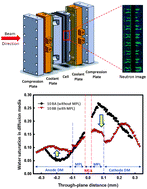In this study, the high resolution hydrogen-deuterium contrast radiography method was applied to elucidate the impact of the micro-porous layer (MPL) on water distribution in the porous fuel cell media. At the steady state, deuterium replaced hydrogen in the anode stream, and the large difference in neutron attenuation of the D2O produced at the cathode was used to track the produced water. It was found that the water content peaked in the cathode-side diffusion media (DM) for the cell without MPL, but with an MPL on the anode and cathode DM, the peak water amount was pushed toward the anode, resulting in a relatively flattened water profile through components and demonstrating a liquid barrier effect. Additionally, the dynamic water behavior in diffusion media was analyzed to understand the effect of a MPL and operating conditions. The water content in the DM changed with applied current, although there is a significant amount of residual liquid content that does not appear to be part of capillary channels. The effect of the MPL on irreducible saturation in DM and cell performance was also investigated.

You have access to this article
 Please wait while we load your content...
Something went wrong. Try again?
Please wait while we load your content...
Something went wrong. Try again?


 Please wait while we load your content...
Please wait while we load your content...